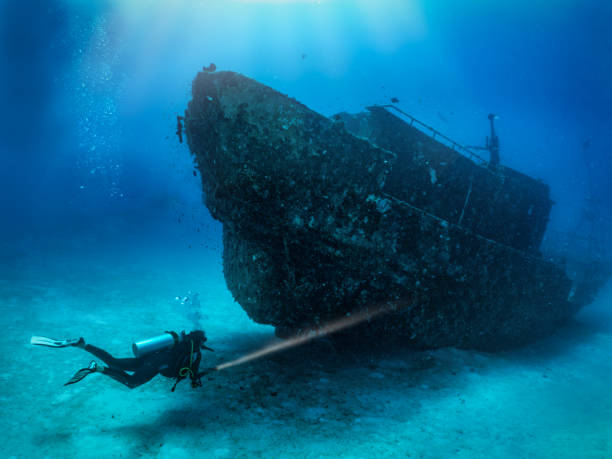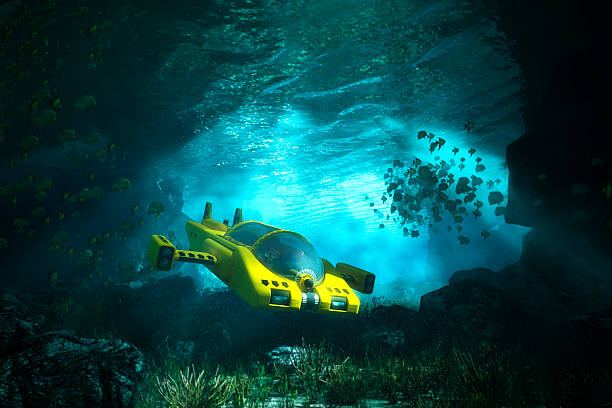
Human curiosity about the ocean dates back to ancient times. Early civilizations were drawn to the sea for navigation and food, laying the groundwork for future exploration. This fascination only grew over centuries, driving advancements in underwater exploration techniques.
Key Milestones in Ocean Exploration
1. Early Navigational Tools
Ancient mariners used tools like the astrolabe and compass to traverse the seas. These instruments were crucial for early voyages of discovery.
2. 19th Century Expeditions
The HMS Challenger expedition (1872-1876) marked a significant leap in scientific oceanography, gathering extensive data on marine life, ocean depths, and currents.
3. World War I
The onset of World War I spurred technological innovations such as sonar, initially developed for submarine detection but later adapted for mapping the ocean floor.
4. Mid-20th Century
Submersibles like the Bathyscaphe Trieste reached new depths. In 1960, Trieste descended into the Mariana Trench, one of the deepest parts of the ocean.
5. Modern Technology
- Remote Sensing: Satellites now provide detailed images of ocean surfaces.
- ROVs (Remotely Operated Vehicles): These unmanned submersibles explore areas too dangerous or deep for human divers.
- Autonomous Underwater Vehicles (AUVs): AUVs autonomously map and sample vast underwater regions.
The evolution from rudimentary tools to advanced robotics underscores our relentless quest to understand the mysteries lurking beneath the ocean’s surface.
Advancing Our Understanding Through Ocean Floor Mapping
Mapping the ocean floor is crucial for expanding our knowledge of marine geology and ecosystems. It helps scientists understand:
- Underwater topography
- Geological features
- Habitats
This understanding offers insights into:
- Tectonic activity
- Volcanic processes
- Biological diversity
Such information is essential for:
- Environmental conservation
- Resource management
- Hazard mitigation
Methods and Technologies for Bathymetric Mapping
Several methods and technologies contribute to bathymetric mapping:
- Sonar (Sound Navigation and Ranging): Utilizes sound waves to detect objects underwater. It measures the time it takes for sound to travel to the ocean floor and back, creating detailed maps of the seabed.
- Satellite Altimetry: Measures sea surface height from space. Variations in sea level can indicate underlying topographical features like mountains or trenches.
- Submersibles and ROVs (Remotely Operated Vehicles): Equipped with high-resolution cameras and sensors, these vehicles capture detailed images and data from the ocean floor.
- Multibeam Echosounders: Emit multiple sound waves at once, covering larger areas compared to single-beam sonar, providing more comprehensive maps.
These technologies have revolutionised our ability to explore previously inaccessible parts of the ocean:
- Multibeam echosounders offer expansive coverage that significantly enhances our understanding of underwater landscapes.
- Satellite altimetry provides crucial data on large-scale features quickly and efficiently.
Advances in ocean floor mapping continue to unveil the mysteries of the deep sea, aiding scientific research and fostering better stewardship of our marine environments.
Overcoming Challenges: The Future of Ocean Exploration
Exploring the ocean depths presents numerous challenges and limitations. Technological constraints remain a significant barrier, particularly when dealing with extreme pressures, low temperatures, and complete darkness. The vastness of the ocean also complicates efforts, requiring substantial resources and time to conduct thorough explorations.
Key Limitations
- Pressure: At extreme depths, pressures can exceed 1,000 atmospheres, posing a danger to both equipment and human explorers.
- Temperature: Near-freezing temperatures in deep-sea environments make it difficult for technology to function optimally.
- Darkness: The lack of sunlight at great depths necessitates advanced lighting solutions for visibility.
- Resource Intensity: Extensive exploration requires significant financial investment and long-term commitment.
Potential Future Advancements
- Robotics: Innovations in autonomous underwater vehicles (AUVs) and remotely operated vehicles (ROVs) are pivotal. These robots can withstand harsh conditions and operate independently or via remote control. Example: WHOI’s Nereus hybrid ROV/AUV successfully dived to the bottom of the Mariana Trench.
- Deep-Sea Imaging Technology: Improved sonar systems and high-resolution cameras enhance our ability to map and document previously unseen areas. Example: Multi-beam sonar systems provide detailed images of the ocean floor, aiding in geological studies.
- Material Science: Development of materials that can endure extreme pressures and temperatures will advance the durability of exploration equipment.
Innovative approaches like these pave the way for more comprehensive ocean exploration, illuminating the mysteries of our planet’s final frontier.
The Importance of Exploring the Ocean
Exploring the ocean is incredibly important for several reasons:
1. Scientific Discovery
The ocean is home to countless life forms, many of which we know very little about. By studying these organisms, we can make exciting scientific discoveries that have the potential to benefit us in various ways:
- Biotechnology: Marine species like sponges and algae have already provided us with new compounds that can be used in medicine and other industries.
- Medicine: Investigating marine organisms could lead to the development of innovative treatments for diseases.
2. Ecosystem Conservation
Understanding marine ecosystems is crucial for protecting them. Here’s why:
- Endangered Species: By exploring the ocean, we can identify endangered species and take steps to ensure their survival.
- Habitat Preservation: Many marine habitats, such as coral reefs, are facing significant threats. Through exploration, we can pinpoint areas that require immediate conservation action.
3. Sustainable Resource Management
The ocean offers valuable resources like fish and minerals, but we must manage them sustainably to avoid depletion:
- Fish Stocks: Overfishing is a serious concern worldwide. By studying fish populations and their habitats, we can implement effective management strategies.
- Mineral Extraction: Understanding the distribution of minerals on the ocean floor helps us extract them responsibly without causing harm to marine life.
Ocean exploration serves as a means to expand our knowledge, protect ecosystems, and use resources wisely. It’s an approach that allows us to benefit from the ocean’s vast potential while ensuring its long-term health.

Conclusion
Ocean exploration is essential for understanding our planet and its ecosystems. By raising public awareness and advocating for this field, we can contribute significantly to scientific progress and environmental preservation.
Preserving unexplored areas is crucial for the well-being of future generations. Through sustainable practices, we can responsibly use ocean resources without harming fragile marine habitats.
Here are some ways you can get involved:
- Citizen Science Initiatives: Take part in projects like tracking marine species or participating in coastal cleanups.
- Educational Programs: Learn more about diving and underwater exploration through organizations like Bali Ocean.
The future of ocean exploration depends on:
- Striking a balance between using and protecting marine resources
- Harnessing technology to aid exploration
- Promoting collaboration on a global scale
Let’s join together to explore, protect, and sustain our oceans for generations to come.
